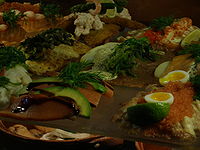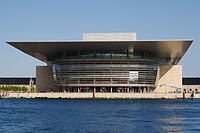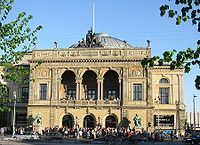- Culture of Denmark
-
The culture of Denmark has some general characteristics often associated with Danish society and everyday culture. Modesty, punctuality but above all equality are important aspects of the Danish way of life.[1] Indeed, deliberate attempts to distinguish oneself from others may be viewed with hostility in line with Jante's Law, respected by some as an unofficial code of Scandinavian conduct. In Denmark, culture and the arts thrive as a result of the proportionately high amount of government funding they receive, much of which is administered by local authorities so as to involve citizens directly.[2] Thanks to a system of grants, Danish artists are able to devote themselves to their work just as museums, theatres, and the film institute receive national support.[3]
Contents
"Hygge"
One of the fundamental aspects of Danish culture is "hygge": spending a calm, comfortable time with good friends or loved ones, often while enjoying good food, snacks and something to drink. Lighting candlelights is also often associated with "hygge". Christmas time, when loved ones sit close together with candles lit on a cold rainy night, is a true moment of "hygge", as is grilling a pølse (Danish sausage) on a long summer evening. These examples, although they do not precisely define "hygge", can give an English speaker an idea of a deeply valued traditional concept of Danish culture.[4]
Danish Christmas
Main article: Jul (Denmark)Hygge and Christmas are also closely related in Denmark. The Danish word for "Christmas" is Jul, from the Old Norse Jól akin to the English Yule.[5]
As such the word does not refer to the birth of Christ, but instead to an ancient pagan winter feast. Its customs have, of course, changed over the years, but it has always been part of Scandinavian culture. It meant so much to the Scandinavians that in order to convert them, the church had to adopt their holiday into Christianity, which is the actual origin of Christmas.[citation needed]
In many countries Christmas is celebrated on the 25th of December, but in Denmark, and in the other Scandinavian countries, it is held on the 24th.
On December the 24th, the family gathers. The morning can be spent in various ways but most often it is the time when preparations are made for the evening.[6]
Juleaften (Danish for Christmas Eve) or Yule Eve starts around 6 p.m. when a traditional dinner is served. The menu is:
- White (boiled) and sugar-browned potatoes, red cabbage and brown sauce (gravy) accompanying either roast duck or goose depending on the size of the family. Some families enjoy a special Danish version of roast pork, called flæskesteg complete with crackling or maybe a special sausage called Medister pølse.
- For dessert, ris á l'amande is served, a name that suggests a French origin - but it is Danish. Sometimes it is confused with rice pudding, since they share the main ingredient (rice). Ris á l'amande needs to be prepared a day in advance, and then on serving, chopped almond and vanilla can be added, among other things. It is served cold, with hot cherry sauce. An unchopped almond is also added and hidden in the rice. The person who finds it in his portion receives a small prize.
Afterwards, the candles on the Christmas tree are lit and the family dance around it singing Christmas songs and carols and subsequently exchange presents.
Danish cuisine
Main article: Danish cuisinePerhaps the most typically Danish contribution to the meals of the day is the traditional lunch or smørrebrød consisting of open sandwiches, usually on thinly sliced rye bread. The meal usually begins with fish such as marinated herring, smoked eel, crab, or breaded plaice filets with remoulade and moves on with slices of roast pork or beef, frikadeller (meat balls), hams and liver paté. The sandwiches are richly garnished with onion rings, radish slices, cucumbers, tomato slices, parsely, remoulade and mayonnaise.[7] The meal is often accompanied by beer, sometimes also by shots of ice-cold snaps or akvavit.
In the evening, hot meals are usually served. Traditional dishes include fried fish, roast pork with red cabbage (perhaps the national dish), pot-roasted chicken, or pork chops. Game is sometimes served in the autumn. Steaks are now becoming increasingly popular.
A popular traditional Danish dessert, especially around Christmas, consists of Æbleskiver, rather like small pancake doughnuts. Æbleskiver are fried in butter in a special pan and are served hot with jam and sugar. Traditionally, they were made with small pieces of apple in the middle of them. Æbleskiver translates into "apple slices".
Danes are known for enjoying an open-minded drinking culture. Buying alcohol is legal in shops at the age of 16, and in bars at 18. There is no minimum drinking age. However teens are traditionally allowed to begin drinking after confirmation as 13-14 year olds.[8]
Cycling
Most Danes are active cyclists, often using their bikes to commute to work or to go off on trips at the weekend. With its well-engineered cycle paths, Copenhagen is especially suited to city cycling. Every day 1.3 million km are cycled in the city,[9] with 36% of all citizens commuting to work, school or university by bicycle[10] Cycling is generally perceived as a healthier, environmentally friendlier, cheaper and often quicker way around town than by public transport or car and it is therefore municipal policy for the number of commuters by bike to go up to 40% by 2012 and 50% by 2015.[11]
Odense has been named the "bicycle city of the year" because of the great number of bicycle lanes in the city. A complete network of 350 km all-weather serviced lanes exists in the town.[12]
During the summer months, there are free "City Bikes" stationed at various spots in the downtown area of Copenhagen, Aarhus and Aalborg. The idea is that anyone can take a bike from one of the spots, ride it to one of the other spots and leave it there for the next person. There are lots of national and regional bicycle routes throughout Denmark. They are all marked and include rest areas with benches and other necessities.
Cultural highlights
Denmark has a rich cultural and intellectual heritage. The astronomical discoveries of Tycho Brahe (1546–1601), Ludwig A. Colding's (1815–1888) neglected articulation of the principle of conservation of energy, and the brilliant contributions to atomic physics of Niels Bohr (1885–1962) indicate the range of Danish scientific achievement. The fairy tales of Hans Christian Andersen (1805–1875), the philosophical essays of Søren Kierkegaard (1813–1855), the short stories of Karen Blixen (penname Isak Dinesen, (1885–1962), the plays of Ludvig Holberg (1684–1754), the modern authors such as Nobel laureate Henrik Pontoppidan and author Herman Bang and the dense, aphoristic poetry of Piet Hein (1905–1996), have earned international recognition, as have the symphonies of Carl Nielsen (1865–1931).
From the mid 1990s Danish movies have attracted international attention, especially those associated with Dogme 95 such as the filmmaker Lars Von Trier. Indeed, the country has always had a strong tradition of movie making and Carl Theodor Dreyer is recognised as having been one of the world's greatest film directors.
Fine arts
Painting
 Frederiksborg Castle by Christen Købke, 1836
Frederiksborg Castle by Christen Købke, 1836 Main article: Danish art
Main article: Danish artDanish painting goes back hundreds of years. Earlier work is often manifested in churches, for example in the form of frescos such as those from the 16th century artist known as the Elmelunde Master. But it was not until the beginning of the 19th century that the Golden Age of Danish Painting emerged with a marked increase in truly Danish art inspired by the country itself with its lifestyle and traditions. Christoffer Wilhelm Eckersberg was an important influence on the following generation’s study of nature, in which landscape painting came to the fore. He had many successful students, including Wilhelm Bendz (1804–1832), Christen Købke (1810–48), Martinus Rørbye (1803–1848), Constantin Hansen (1804–1880), Jørgen Roed (1808–1888), Wilhelm Marstrand (1810–1873), Constantin Hansen (1804–80), C.A. Jensen (1792–1870), J.Th. Lundbye (1818–1848), and P.C. Skovgaard (1817–1875).[13]
Some years later, a number of painters including P.S. Krøyer (1851–1909) and Michael (1849–1927) and Anna Ancher (1859–1935) moved to Skagen in the far north of Jutland to paint the natural surroundings and local people. In due course, the town developed into an artists' colony. A little later, a similar phenomenon developed on Funen with artists such as Johannes Larsen (1867–1961). Vilhelm Hammershoi is an important painter too.
Collections of modern art enjoy unusually attractive settings at the Louisiana Museum north of Copenhagen, at the North Jutland Art Museum in Aalborg and at the ARoS art museum in Aarhus. The National Museum of Art and the Glyptotek, both in Copenhagen, contain treasures of Danish and international art.
Literature
Main article: Danish literatureThe principal contributors to Danish literature are undoubtedly Hans Christian Andersen (1805–1875) with his fairy tales, the philosopher Søren Kierkegaard (1813–1855), storyteller Karen Blixen (1885–1962), playwright Ludvig Holberg (1684–1754), and modern authors such as Henrik Pontoppidan and Herman Bang.
Among today's Danish writers, probably the best-known to international readers is Peter Høeg (Smilla's Sense of Snow; Borderliners). Benny Andersen writes poems, short stories, and music. Poems by both writers have been translated into English by the Curbstone Press. Klaus Rifbjerg has published over 100 novels as well as poetry, short stories and TV plays. Two of his works have been translated into English: Witness to the Future and War. Kirsten Thorup's novel Baby, winner of the 1980 Pegasus Prize, is published in English by the University of Louisiana Press. The psychological thrillers of Anders Bodelsen also appear in English as do some of the novels of intrigue by Leif Davidsen. Suzanne Brøgger and Vita Andersen focus largely on the changing roles of women in society.
 Grundtvig's Church, Copenhagen
Grundtvig's Church, Copenhagen
Architecture
Main article: Architecture of Denmark The Sydney Opera House designed by Danish architect Jørn Utzon
The Sydney Opera House designed by Danish architect Jørn Utzon
The architecture of Denmark has its origins in the Viking period but became recognizable in the Middle Ages when first Romanesque, then Gothic churches and cathedrals sprang up throughout the country. Inspired by French castles and with the assistance of Dutch designers, architecture during the Renaissance flourished with magnificent royal palaces. Neoclassicism came to Denmark from France and, in the 19th century, slowly merged into the National Romantic style when Danish designers came into their own. It was, however, not until the last half of the 20th century that Danish architects entered the world scene with their highly successful Functionalism. This, in turn, has evolved into more recent world-class designers such as Johann Otto von Spreckelsen who designed the Grande Arche in Paris. Internationally, perhaps the most celebrated of all is the architect who designed the iconic Sydney Opera House, Jørn Utzon, but within Danish borders, it is the architect Arne Jacobsen who is perhaps held in highest esteem for developing the 'Danish Modern' style and furniture/interior design, such as the now world-famous and much sought-after Swan and Egg chairs.[14] A new wave of young Danish architects are rising into international prominence, like Bjarke Ingels with works such as the Danish National Pavilion at the Shanghai 2010 Expo
Photography
Main article: Photography in Denmark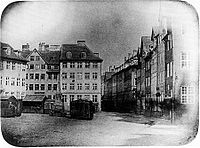 Peter Faber: Ulfeldts Plads, Copenhagen (1840). Denmark's oldest photograph
Peter Faber: Ulfeldts Plads, Copenhagen (1840). Denmark's oldest photograph
Photography in Denmark has developed from strong participation and interest in the very beginnings of the art in 1839 to some of the strongest contemporary photography in Europe today. Pioneers such as Mads Alstrup and Georg Emil Hansen paved the way for a rapidly growing profession during the last half of the 19th century while both artistic and press photographers have since made internationally recognised contributions. Today Danish photographers such as Astrid Kruse Jensen and Jacob Aue Sobol are active both at home and abroad, participating in key exhibitions around the world.[15]
Danish design
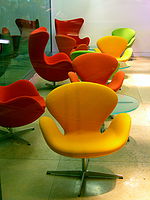 Arne Jacobsen's The Swan and the Egg
Arne Jacobsen's The Swan and the Egg Main article: Danish design
Main article: Danish designDanish applied art and industrial design have won many international awards for excellence. The name of Georg Jensen (1866–1935) is known the world over for modern design in silver. The Danish Porcelain Factory ("Royal Copenhagen"), including Bing & Grøndahl, is famous for the quality of its porcelain and ceramics and export products worldwide. Danish design is also a well-known brand, often associated with world-famous designers and architects such as Børge Mogensen, Poul Kjærholm, Hans Wegner, Poul Henningsen and Arne Jacobsen. The Danish Museum of Art & Design in Copenhagen exhibits the best in Danish design.
Performing arts
Music
Main article: Music of DenmarkDenmark's most famous composer is Carl Nielsen who is best known for his six symphonies. Other well-known pieces of his are the incidental music for Adam Oehlenschläger's drama Aladdin (Nielsen), the operas Saul og David and Maskarade, the concertos for flute, violin, and clarinet, the Wind Quintet, and the Helios Overture, which depicts the passage of the sun in the sky from dawn to nightfall.
However Denmark has also produced a number of modern musicians. Examples such as D-A-D, Aqua and Dizzy Mizz Lizzy have become well known.
The Royal Danish Ballet specializes in the work of Danish choreographer August Bournonville (1805–79). Danes have distinguished themselves as jazz musicians, and the Copenhagen Jazz Festival has acquired an international reputation. The modern pop and rock scene has produced a few bands of note (for example, The Raveonettes, Kashmir, Junior Senior and Mew).
Hans Abrahamsen, Per Nørgård and Poul Ruders are successful contemporary composers.
Danish interest in music is exemplified by the prestigious Opera House completed in 2000. Strategically set on Copenhagen's waterfront, it has presented operas and musicals to full houses ever since its opening.
Not to be forgotten is the Black Metal scene, which although underground has a hub of followers.
Cinema
Main article: Cinema of DenmarkIn recent years, Danish films have gained increasing recognition at home and abroad. Gabriel Axel's film based on Karen Blixen's Babette's Feast was awarded an Oscar in 1987. In 1988, Bille August also received an Oscar with Pelle the Conqueror based on the novel by Martin Andersen Nexø. In 1992, August went on to win the Palme d'Or in Cannes with Ingmar Bergman's autobiography, The Best Intentions.
Since the late 1990s, the Dogme movement and figures such as Lars von Trier, Thomas Vinterberg, Søren Kragh-Jacobsen and Lone Scherfig have continued to contribute to the international success of Danish cinema.[16] In 2011, Susanne Bier's In a Better World won the Academy Award for Best Foreign Language Film.
Theatre
Main article: Theatre in DenmarkThe theatre in Denmark continues to thrive thanks to the many theatres in Copenhagen and across the country which put on a wide variety of Danish and foreign performances. The flagship Royal Danish Theatre presents drama, opera, ballet and music. Since the 18th century, Danish playwrights have been successful in attracting wide public interest.
Ludvig Holberg (1684–1754) is considered by many to be the founder of the Danish theatre. Satirical comedies such as Jean de France and Jeppe of the Hill are still performed today.[17]
Adam Oehlenschläger (1779–1850) introduced romanticism to the Danish theatre. Especially successful was his Earl Hakon the Mighty, premiered in 1808.
The Norwegian Henrik Ibsen (1828–1906) also travelled to Copenhagen where he produced numerous plays such as A Doll’s House (1879).[18]
In recent years, there has been something of a revival in Danish theatre. Many new playwrights and producers have appeared including Astrid Saalbach (b.1955), winner of the Nordic Drama Award in 2004, and Peter Asmussen (b.1957), who wrote the film script for Lars von Trier's Breaking the Waves. Danish musicals have also been a particularly successful feature of the modern theatre. Knud Christensen, commonly known as Sebastian, was particularly successful with Cyrano (1992), based on Rostand’s play and Klokkeren fra Notre Dame (The Hunchback of Notre Dame) (2001). Bent Fabricius-Bjerre's musical Matador (2007) is based on a successful TV series of the same name.[19]
Another popular Danish theatrical tradition is the revue which has been thriving since the mid 19th century. Today revues are performed every summer to full houses in theatres across Denmark, poking fun at the politics of the day and even the monarchy. Among the most popular are Circusrevyen in Copenhagen with Lisbet Dahl, and the Nykøbing Revy directed by Flemming Krøll in Nykøbing Falster.[20]
Finally, Danish television has also contributed to drama with a number of successful series since the 1970s.
Other contributions
During the Christmas holidays (known as Jul), making Christmas decorations is a big family event. Spending hours around a table with the family cutting paper into intricate designs has become a national pastime.
Danes have made significant contributions to the field of computer science. Some notable figures are:
- Per Brinch Hansen: Known for concurrent programming theory
- Bjarne Stroustrup: Inventor of C++ programming language
- Anders Hejlsberg: Inventor of Turbo Pascal, lead architect for C#
- Janus Friis: Co-Inventor of Skype
- David Heinemeier Hansson: Created Ruby on Rails
- Lars Rasmussen and Jens Rasmussen: Came up with Google Maps and Google Wave
- Lars Bak: Created V8 Javascript VM for Google Chrome
- Peter Naur: Turing Award winner, contributed to ALGOL 60
- Rasmus Lerdorf: Created PHP
Sexual equality is a high priority in Denmark. Danes are quite liberal and tolerant towards sexual minorities.
Copenhagen is a popular destination for lesbian and bisexual travellers.[21] The main gay and lesbian festival of the year is the Copenhagen Pride parade, a big Mardi Gras-like bash that occurs on a Saturday in early August. There's also the Copenhagen Gay & Lesbian Film Festival, held each year in October. In addition, Copenhagen has been host to the 2009 World Outgames. The LBL (Landsforeningen for Bøsser og Lesbiske, a national organisation for gay men and lesbians) was established in 1948, and in 1989 Denmark became the first country in Europe to offer gay partners most of the same legal rights as heterosexual couples. Adoption laws are liberal compared to other Western countries and public displays of affection between people of the same sex are unlikely to provoke ire. Lesbians wishing to have access to artificial insemination do not provoke the sort of scandals that can occur in other societies,[22] and in March 2009 adoption was legalized for homosexual couples.
Sport
Main article: Sports in DenmarkSports are popular in Denmark, and its citizens participate in and watch a wide variety. The national sport is football with the most notable results being qualifying for the European Championships six times in a row (1984–2004) and winning the Championship in 1992 after being allowed to enter the competition due to the withdrawal of Yugoslavia. Other significant achievements include winning the Confederations Cup in 1995 and reaching the quarter final of the 1998 World Championships.
Other popular sports include handball, cycling, sailing sports, tennis, badminton, ice hockey, and golf.
See also
Further reading
- Morten Strange, "Culture Shock! Denmark", London: Kuperard, 1996, 228 pp. ISBN 1-85733-159-1.
- Helen Dyrbye, Steven Harris, Thomas Golzen, "The Xenophobe's Guide to the Danes", Horsham, West Sussex: Ravette Publishing, 1997, 64 pp.
Culture of Europe Sovereign
states- Albania
- Andorra
- Armenia
- Austria
- Azerbaijan
- Belarus
- Belgium
- Bosnia and Herzegovina
- Bulgaria
- Croatia
- Cyprus
- Czech Republic
- Denmark
- Estonia
- Finland
- France
- Georgia
- Germany
- Greece
- Hungary
- Iceland
- Ireland
- Italy
- Kazakhstan
- Latvia
- Liechtenstein
- Lithuania
- Luxembourg
- Macedonia
- Malta
- Moldova
- Monaco
- Montenegro
- Netherlands
- Norway
- Poland
- Portugal
- Romania
- Russia
- San Marino
- Serbia
- Slovakia
- Slovenia
- Spain
- Sweden
- Switzerland
- Turkey
- Ukraine
- United Kingdom
- (England
- Northern Ireland
- Scotland
- Wales)
- Vatican City
States with limited
recognition- Abkhazia
- Kosovo
- Nagorno-Karabakh
- Northern Cyprus
- South Ossetia
- Transnistria
Dependencies
and other territories- Åland
- Faroe Islands
- Gibraltar
- Guernsey
- Jan Mayen
- Jersey
- Isle of Man
- Svalbard
Other entities - European Union
 Denmark topics
Denmark topicsHistory Geography Government
& PoliticsMonarchy List · Family tree · Succession · Crown Regalia · Order of the Elephant · Order of the Dannebrog · Royal residencesEconomy National Bank · Stock Exchange · Krone · Taxation · Companies · Communications · Transport · TourismSociety Culture Language · Cinema · Cuisine · Literature · Modern Breakthrough · Music (List) · Art (List) · Architecture · Photography · Public holidays · Sport · Jante Law · Scout CouncilSymbols References
- ^ Denmark - Language, Culture, Customs and Etiquette. From Kwintessential. Retrieved 4 December 2008.
- ^ "Kommuner bruger flere penge på kultur", Dr.dk. (Danish)
- ^ "The History of Danish Arts Policy", DanishArts.info. Retrieved 13 March 2010.
- ^ The Danish Art of Hygge from Visit Denmark. Retrieved 4 December 2008.
- ^ Den Store Danske, Jul (in Danish). Retrieved 31 July 2009.
- ^ Danish Christmas traditions from VisitDenmark. Retrieved 25 July 2009.
- ^ Danish Culture from PortlandDanes.org. Retrieved 4 December 2008.
- ^ Alcohol culture in Denmark. From webbyen. Retrieved August 27 2009.
- ^ "Bicycle Account - 2004Street". Copenhagen Municipality. http://www.walkandbikeforlife.org/Articles/Copenhagen%20City%20Of%20Cyclists.pdf. Retrieved 2009-10-30.
- ^ "Bike City Copenhagen". Københavns Kommune. http://www.visitcopenhagen.com/content/tourist/what_to_see_and_do/events/event_calendar/major_event_-_information?EventID=590. Retrieved 2009-01-05.
- ^ "Grønne cykel router". Københavns Kommune. http://www.kk.dk/Borger/ByOgTrafik/cyklernesby/groennecykelruter.aspx. Retrieved 2009-01-05.[dead link]
- ^ "Inspiration fra cykelbyen", Odense.dk. (Danish) Retrieved 10 June 2010
- ^ Visual Arts from Ministry of Foreign Affairs, Denmark. Retrieved 4 December 2008.
- ^ 'Ægget' fejrer 50 år med en særlig stol. Politiken 9. jan 2008 kl. 07:41. link title
- ^ Contemporary Danish Photography. From Photography-Now. Retrieved 28 January 2010.
- ^ Cinema fact sheet from Ministry of Foreign Affairs of Denmark. Retrieved 5 December 2008.
- ^ Theatre from Denmark.dk. Retrieved 22 December 2008.
- ^ Theatre from Golden Days in Copenhagen. Retrieved 22 December 2008.
- ^ Matador-stjerner er enige: Det betød alt from Avisen.dk (in Danish). Retrieved 23 December 2008.
- ^ "Danmark - revy", Den store Danske. (Danish) Retrieved 19 March 2010.
- ^ Gay Copenhagen from VisitCopenhagen.com. Retrieved 5 December 2008.
- ^ Gay Copenhagen - Tolerant and Relaxed from Copenhagen Lodgings. Retrieved 5 December 2008.
External links
- Danish Food Culture and a dilicious taste of Denmark
- Facts about Denmark & Danish Culture
- Visitdenmark.com
- [1] Figuring out Hyggelig.
Culture of Europe Sovereign
states- Albania
- Andorra
- Armenia
- Austria
- Azerbaijan
- Belarus
- Belgium
- Bosnia and Herzegovina
- Bulgaria
- Croatia
- Cyprus
- Czech Republic
- Denmark
- Estonia
- Finland
- France
- Georgia
- Germany
- Greece
- Hungary
- Iceland
- Ireland
- Italy
- Kazakhstan
- Latvia
- Liechtenstein
- Lithuania
- Luxembourg
- Macedonia
- Malta
- Moldova
- Monaco
- Montenegro
- Netherlands
- Norway
- Poland
- Portugal
- Romania
- Russia
- San Marino
- Serbia
- Slovakia
- Slovenia
- Spain
- Sweden
- Switzerland
- Turkey
- Ukraine
- United Kingdom
- (England
- Northern Ireland
- Scotland
- Wales)
- Vatican City
States with limited
recognition- Abkhazia
- Kosovo
- Nagorno-Karabakh
- Northern Cyprus
- South Ossetia
- Transnistria
Dependencies
and other territories- Åland
- Faroe Islands
- Gibraltar
- Guernsey
- Jan Mayen
- Jersey
- Isle of Man
- Svalbard
Other entities - European Union
Categories:- Danish culture
Wikimedia Foundation. 2010.

